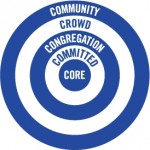Concentric Circles
 I’ve found Saddleback’s concentric circle idea to be very helpful in explaining a number of small group related concepts. Here’s my version.
I’ve found Saddleback’s concentric circle idea to be very helpful in explaining a number of small group related concepts. Here’s my version.
Basic idea? The largest circle represents the community you’re in. They are who you’re trying to reach. The crowd represents the group that considers your church to be their church. They may not come all the time, but if asked where they go to church they name your church. The congregation represents the group that are actually members of your church. They attend more frequently. Committed is a step towards greater commitment. They’re serving in some way. Core is the most committed bunch you’ve got. Serving. Giving. Leading in some way.
How does this play into small group ministry? Here are a just few ideas:
- Most churches are attempting a version of core to crowd small group ministry. By that I mean that in order to lead a group you’re recruited and selected for leadership training based on already being known and involved. Consequence? It severely impacts the ability of the group to reach and connect beyond the congregation.
- Since the community is more likely to walk across the cul-de-sac than come into your auditorium it makes sense to find ways to help them connect in community before they attend your service.
- The deeper a person’s commitment to your church (core and committed) the less likely they are to have deep friendships with people who are in the community. While there are exceptions, this is generally true. As a result, if the most likely accepted invitation to a small group is made by a friend, it makes sense to help your congregation and crowd invite the community.


You make it sound like the more someone is involved with the church, then the less likely they are to have friends outside the church, and vice versa, but these people are the ones that should be making the invitation to the community.
Hi Katie…you’re reading it correctly. “Should be making the invitation” is rarely what actually happens. Although there are certainly exceptions, the longer one is connected internally, the fewer active relationships are developed or nurtured externally. Might be different in your country…but I doubt it.
mark
these 2 concentric circles has a similarity to the 3 concentric circles from The Urantia Book
[…] in groups (the Easter adult attendance number is often used to reflect the number of adults in the crowd). This will inspire reminiscing about the future, when responding to the past is the […]